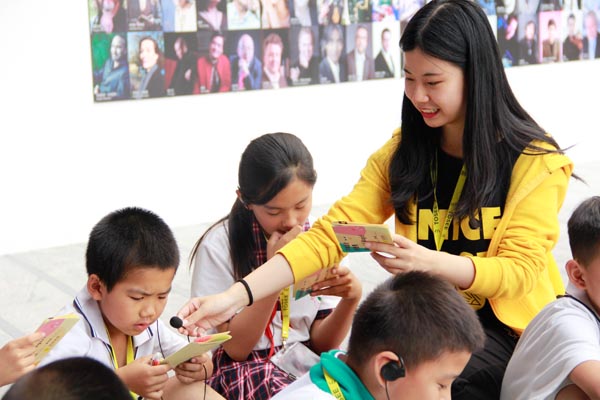Palace Museum is a wonderland for the imagination
 0 Comment(s)
0 Comment(s) Print
Print E-mail China Daily, November 22, 2019
E-mail China Daily, November 22, 2019

It's a dilemma facing parents the world over. Where to bring the children for a weekend treat? Compared to a thrilling roller coaster ride at theme parks, there is a more down-to-earth option that provides plenty of fun and education-the Palace Museum.
The 600-year-old wonderland of spectacular pavilions, imperial gardens and valuable artworks can guarantee quality time for both parents and children. It proves that imagination can be the best playground.
Yiyi, an 8-year-old boy, is a case in point. He and his parents head to the museum almost every weekend to attend a special class where the lecturers bring artifacts displayed in the splendid wooden construction to life with vivid tales and good stories, allowing both adults and children to understand their design and cultural value.
Most of the lecturers are researchers at the Palace Museum or scholars from the Central Academy of Fine Arts, and the course topics range from Chinese traditional rituals and architecture to calligraphy and bronze wares.
After the class, a workshop is held to help children to create their own artworks such as paintings, works of pottery and sculptures based on what they have learned that day.
"The lecturers are patient in communicating with children and are adept at creating games to help them better digest the information," says Yiyi's mother, Pang Weilin.
"Being a frequent visitor to the museum, he can observe how the scenery changes throughout the seasons. Both the surroundings and the courses help him become more sensitive to art and beauty," she says, adding that many parents, including her and her husband, also join their children in the museum discovery tours.
The class and the workshop are parts of a program initiated by the museum and the art education provider Tosee Art, which was set up four years ago.
Tosee Art has collaborated with over 300 experts and artists, and 30 art institutions, including the Palace Museum, the National Museum of China, Dunhuang Academy and Today Art Gallery, to launch art courses in these spaces for students aged 5 to 12.
Chen Keyi, founder of Tosee Art, says: "We act as a bridge linking high-quality art education resources with children who are curious about art. I believe that these lecturing artists' enthusiasm for their specialties will influence the children."

A graduate of arts administration at the Central Academy of Fine Arts, the 27-year-old knows how important it is to see art in exhibitions and have a good teacher to explain and guide you.
When she was a primary school pupil in Zhuzhou, Hunan province, her art teacher drove them to the provincial museum in Changsha city to see an oil painting exhibition. This experience gave her an early, precious insight into art.
"That sowed a seed in my heart. I was astounded by the pieces and felt strongly motivated," she says.
Hence, when Chen took part-time jobs as an art teacher at training agencies during her college years, she often brought her students to museums and galleries.
She then found that many parents are enthusiastic about sending their children to learn about art at museums. But children, as any parent knows, have minds of their own and many just rush past the artwork without taking anything in.
As an art enthusiast, Chen felt a sense of responsibility to do something for families in need of an immersive art education experience at museums and galleries.
In 2015, Chen began to provide art education courses that lean more on using art as a way to perceive the beauty of the outside world and for people to express themselves rather than simply learning art-related knowledge and skills.
For instance, Chen says, when they bring students to see paintings displayed at a museum, instead of merely introducing the painters and the schools of art, lecturers would first ask them to observe the artworks with certain background music.
"The children then get exposure to multiple sensory experiences," she says.
To help children stay focused on class content, games have been integrated into the curriculum, such as treasure hunts around the Palace Museum to see how many statues of mythical animals they can find in certain areas. If they catch sight of a bronze crane, they insert a given card that introduces the sculpture into a handbook. In the game, which is also a learning tool, they try to find more animals and fill the book with more cards.
"Our team has designed various teaching aids according to the different themes of the exhibitions, offering children some kind of interactive learning experience," says Chen.
Chen's team organizes monthly informative tours to selected exhibitions in Beijing.
"We usually assess the level and quality of the exhibition, as well as the environment and location of the place that is holding it," she adds.
"Most importantly, we'll make sure that we have a passionate lecturer specialized in that field."
To reach out to more children, Chen says, an online audio course titled Hello, Forbidden City was released this year and has been subscribed to by over 100,000 families in 34 provinces, municipalities and autonomous regions in China.
"I hope we can gather top-class art education resources in China and then benefit more children and parents across the country," she says.






Go to Forum >>0 Comment(s)